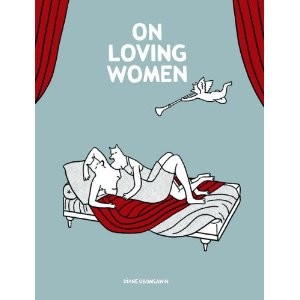Everyone remembers their first love, when they were swept off their feet — and no relationship will ever be the same. For, the characters in the graphic novel, On Loving Women, this moment comes with their first same-sex attraction.

In lieu of the traditional coming out story, Montreal author/artist Diane Obomsawin presents a series of quirky black and white comic strips depicting the episodes of her friends’ lives surrounding this self-realization. The result is a charming, honest and sincere look into the lives of these women.
The stories themselves do not form a unified narrative but are rather presented as multiple voices relaying a general experience.
Instead of a traditional page numbering system, each tale is self-contained and has its own page count. Separating events out in this way highlights the importance of each individual’s experience. The focus is on the protagonists gradual self-realization; not only as a queer person through the coming out process but also as someone who can not abide by societal norms.
This movement to self-awareness takes many forms.
In compiling the work, great care was given to provide a simple, straightforward and honest account. None of the stories shy away from illustrating the situations that arose through this process. Viewed through the lens chosen by the author, such acts are approachable without value judgements being made. These are real human beings, with strengths and flaws just like everyone.
Some stories seem to end with the main character on their way to a magical ending, where everyone is happy for the rest of their lives. Others, however, are not so lucky and come across homophobic behaviour from their environment. Regardless of the ending, there is always a sense that the story does not end there. The reader is very aware that the characters presented are real people, whose lives continue off the page.
The reality of the subject matter is put into contrast with the art style itself. The black and white drawings are simple while still being poignant at conveying the message. The background scenes and clothing are all drawn in grayscale so as to highlight the white characters. Colour is then filled in by the reader so the characters may be of any background or ethnicity.
Although the stylistic choice of using animal heads to represent human characters may seem odd at first, it works rather well. The type of animal used for the episode is often tied to protagonists themselves. For example, in the first story, the main character expresses her love of Wonder Woman’s horse-like appearance. This stylistic choice frees the artist to explore very intimate moments.
In service to the story, only some of the panels feature nude women thus there is only a very minimal risk of these scenes being viewed as lewd or gratuitous. Instead, they come across as very tender and largely heartwarming.
Although this work is about the first same-sex attraction of a group of women, there is a universal message. It is not about being queer, or even falling in love. On Loving Women is about the discovery of the self in all its dimensions, even if it clashes with the norms set by society.
You can pick up a copy of On Loving Women at Drawn & Quarterly for $16.95.
Diane Obomsawin will be at Toronto Comic Arts Festival May 10-11.




